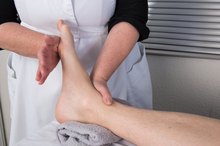Foot Pain in the Heel From Playing Soccer
Although soccer can be an entertaining form of exercise, the running and jumping involved can put you at risk for injuries and conditions that cause heel pain. It can vary in severity, ranging from a mild ache to a debilitating pain that keeps you from playing or practicing. Because it can sometimes be a symptom of a serious condition or injury, it is important to understand what can cause soccer-related heel pain and how it can be remedied.
If you are experiencing serious medical symptoms, seek emergency treatment immediately.
Symptoms
Heel pain can develop in just one or both of the feet. It can occur without warning or after starting a new sport such as soccer. Pain can intensify when you jump, run or squeeze or contract the muscles in the feet. People that develop heel pain can have the tendency to tiptoe when walking. Additional symptoms can include bruising, warmth, redness, inflammation and tenderness. You my also notice loss of mobility or problems with stability.
- Heel pain can develop in just one or both of the feet.
- Pain can intensify when you jump, run or squeeze or contract the muscles in the feet.
Causes
Have Heel Spurs? How to Strap Your Foot
Learn More
Heel pain as the result of playing soccer can occur if you overuse the muscles and tendons in the feet with excessive exercise or training 2. In addition, you can experience pain if you sprain, strain, fracture or dislocate ligaments, muscles, tendons or bones in the heel area. Some painful conditions such as plantar fasciitis, heel pad atrophy, tarsal tunnel syndrome, Sever’s disease and tumors can also develop from excessive or extreme soccer play.
Treatments
Apply an ice pack to the heel area for about 10 minutes, three times a day. Wrap the injured foot with an elastic bandage to reduce swelling and pain. Elevate your foot to help any fluid drain away from your foot and toward your heart. Take an over-the-counter pain control medication such as acetaminophen or ibuprofen. Contact a doctor if pain is unbearable or lingers even after home treatment. Serious injuries such as fractures and tumors may require surgery.
- Apply an ice pack to the heel area for about 10 minutes, three times a day.
- Wrap the injured foot with an elastic bandage to reduce swelling and pain.
Prevention
What Cardio Can You Do With Heel Spurs?
Learn More
Prevent heel pain by wearing a stable arch support in your soccer cleat. Stretch the muscles of the calves and hamstrings, and the tendons located at the backs of the legs prior to exercise. Refrain from running on hard surfaces and always wear shoes with shock-absorbent soles to minimize impact. If you are susceptible to heel pain, stretch out and apply ice to the heel right after you play soccer to prevent it from reoccurring.
- Prevent heel pain by wearing a stable arch support in your soccer cleat.
- If you are susceptible to heel pain, stretch out and apply ice to the heel right after you play soccer to prevent it from reoccurring.
Related Articles
References
- American Academy of Family Physicians: Diagnosing Heel Pain in Adults
- "Foot & Ankle Center of Washington"; Heel Pain in Soccer Playing Kids; Doug Hale, DPM and Larry Huppin, DPM; April 2010
- FamilyDoctor: Sever's Disease: A Common Cause of Heel Pain
- The Merck Manuals: Approach to Sports Injuries
- American Academy of Orthopedic Surgeons. (2017). Heel Pain. https://orthoinfo.aaos.org/en/diseases--conditions/heel-pain
- Tu P, Bytomski JR. Diagnosis of Heel Pain. Am Fam Physician. 2011 Oct 15;84(8):909-16. https://www.aafp.org/afp/2011/1015/p909.html
- Tu P, Bytomski JR. Diagnosis of heel pain. Am Fam Physician. 2011;84(8):909-16.
- Lim AT, How CH, Tan B. Management of plantar fasciitis in the outpatient setting. Singapore Med J. 2016;57(4):168-70. doi:10.11622/smedj.2016069
- Li HY, Hua YH. Achilles Tendinopathy: Current Concepts about the Basic Science and Clinical Treatments. Biomed Res Int. 2016;2016:6492597. doi:10.1155/2016/6492597
- Gulati V, Jaggard M, Al-nammari SS, et al. Management of achilles tendon injury: A current concepts systematic review. World J Orthop. 2015;6(4):380-6. doi:10.5312/wjo.v6.i4.380
- Hong CH, Lee YK, Won SH, Lee DW, Moon SI, Kim WJ. Tarsal tunnel syndrome caused by an uncommon ossicle of the talus: A case report. Medicine (Baltimore). 2018;97(25):e11008. doi:10.1097/MD.0000000000011008
- Mayer SW, Joyner PW, Almekinders LC, Parekh SG. Stress fractures of the foot and ankle in athletes. Sports Health. 2014;6(6):481-91. doi:10.1177/1941738113486588
- Tu P. Heel Pain: Diagnosis and Management. Am Fam Physician. 2018;97(2):86-93.
- Yi TI, Lee GE, Seo IS, Huh WS, Yoon TH, Kim BR. Clinical characteristics of the causes of plantar heel pain. Ann Rehabil Med. 2011;35(4):507-13. doi:10.5535/arm.2011.35.4.507
- Kucuksen S, Karahan AY, Erol K. Haglund syndrome with pump bump. Med Arch. 2012;66(6):425-7.
- Vaishya R, Agarwal AK, Azizi AT, Vijay V. Haglund's Syndrome: A Commonly Seen Mysterious Condition. Cureus. 2016;8(10):e820. doi:10.7759/cureus.820
- Pękala PA, Henry BM, Pękala JR, Piska K, Tomaszewski KA. The Achilles tendon and the retrocalcaneal bursa: An anatomical and radiological study. Bone Joint Res. 2017;6(7):446-451. doi:10.1302/2046-3758.67.BJR-2016-0340.R1
- Helgeson K. Examination and intervention for sinus tarsi syndrome. N Am J Sports Phys Ther. 2009;4(1):29-37.
- Ma DL, Vano-galvan S. Piezogenic pedal papules. CMAJ. 2013;185(18):E847. doi:10.1503/cmaj.121963
- Fritz JM, Mcdonald JR. Osteomyelitis: approach to diagnosis and treatment. Phys Sportsmed. 2008;36(1):nihpa116823. doi:10.3810/psm.2008.12.11
- Yan L, Zong J, Chu J, et al. Primary tumours of the calcaneus. Oncol Lett. 2018;15(6):8901-8914. doi:10.3892/ol.2018.8487
- Narváez JA, Narváez J, Ortega R, Aguilera C, Sánchez A, Andía E. Painful heel: MR imaging findings. Radiographics. 2000;20(2):333-52. doi:10.1148/radiographics.20.2.g00mc09333
- Thomas JL, Christensen JC, Kravitz SR, et al. The diagnosis and treatment of heel pain: a clinical practice guideline-revision 2010. J Foot Ankle Surg. 2010;49(3 Suppl):S1-19. doi:10.1053/j.jfas.2010.01.001
- Noor S, Khan RU, Ahmad J. Understanding Diabetic Foot Infection and its Management. Diabetes Metab Syndr. 2017;11(2):149-156. doi:10.1016/j.dsx.2016.06.023
- Lui E. Systemic causes of heel pain. Clin Podiatr Med Surg. 2010;27(3):431-41. doi:10.1016/j.cpm.2010.04.004
- Podolsky R, Kalichman L. Taping for plantar fasciitis. J Back Musculoskelet Rehabil. 2015;28(1):1-6. doi:10.3233/BMR-140485
- Habets B, Van cingel REH, Backx FJG, Huisstede BMA. Alfredson versus Silbernagel exercise therapy in chronic midportion Achilles tendinopathy: study protocol for a randomized controlled trial. BMC Musculoskelet Disord. 2017;18(1):296. doi:10.1186/s12891-017-1656-4
- Riskowski J, Dufour AB, Hannan MT. Arthritis, foot pain and shoe wear: current musculoskeletal research on feet. Curr Opin Rheumatol. 2011;23(2):148-55. doi:10.1097/BOR.0b013e3283422cf5
- Donley BG, Moore T, Sferra J, Gozdanovic J, Smith R. The efficacy of oral nonsteroidal anti-inflammatory medication (NSAID) in the treatment of plantar fasciitis: a randomized, prospective, placebo-controlled study. Foot Ankle Int. 2007;28(1):20-3. doi:10.3113/FAI.2007.0004
- Sahu RL. Percutaneous planter fasciitis release under local anesthesia: A prospective study. Chin J Traumatol. 2017;20(2):87-89. doi:10.1016/j.cjtee.2017.01.002
- American Academy of Orthopedic Surgeons. (2017). Heel Pain.
- Buchbinder R. (2018). Patient education: Heel and foot pain (caused by plantar fasciitis) (Beyond the Basics). Isaac Z, ed. UpToDate. Waltham, MA: UpToDate Inc.
- Lareau CR, Sawyer G, Wang JH, DiGiovanni CW. Plantar and medial heel pain: diagnosis and management. J Am Acad Orthop Surg. 2014 Jun;22(6):372-80. doi: 10.5435/JAAOS-22-06-372
- Ma DL, Vano-Galvan S. Piezogenic pedal papules. CMAJ. 2013 Dec 10;185(18):E847. doi: 10.1503/cmaj.121963
- Tu P, Bytomski JR. Diagnosis of Heel Pain. Am Fam Physician. 2011 Oct 15;84(8):909-16.
- Vaishya R, Agarwal AK, Azizi AT, Vijay V. Haglund's Syndrome: A Commonly Seen Mysterious Condition. Cureus. 2016 Oct;8(10):e820. doi: 10.7759/cureus.820
Writer Bio
Rose Erickson has been a professional writer since 2010. She specializes in fitness, parenting, beauty, health, nutrition and saving money, and writes for several online publications including The Krazy Coupon Lady. She is also a novelist and a mother of three.








